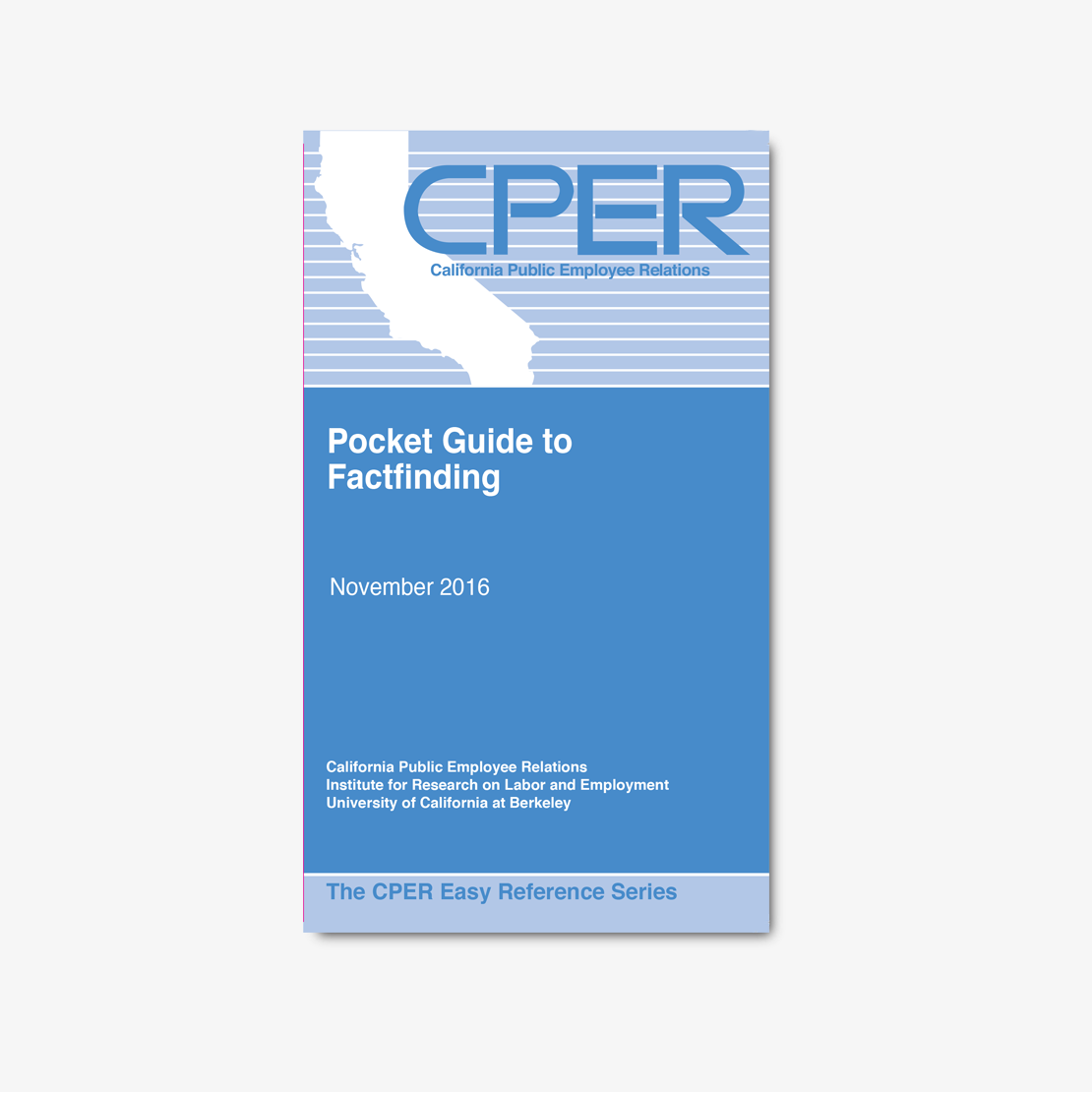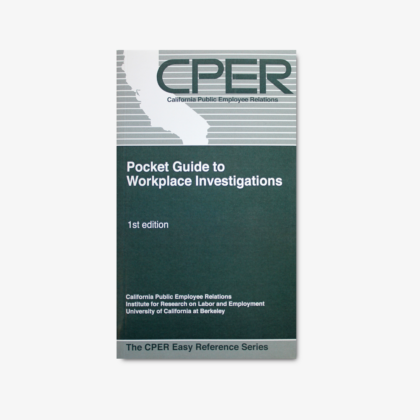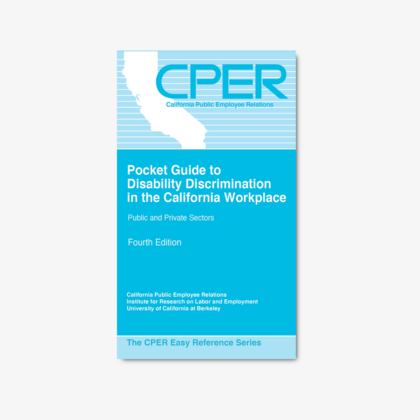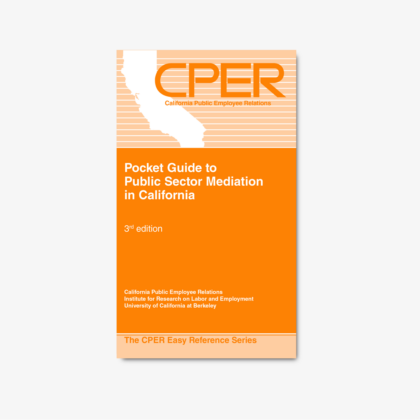This compact resource explains the statutory requirements, best practices and practical basics for the four public sector labor relations statutes in California that require factfinding…EERA, HEERA, MMBA and IHSSEERA.
CPER’s newest guide covers:
- Impasse and factfinding process
- Analyzing and presenting factfinding criteria
- Factfinding and the good faith duty to bargain
- Scope of bargaining and factfinding
- Major court cases and decisions
- Pertinent statutes
- PERB regulations
- Resources
- Factfinding timelines
Table Contents
- Introduction (Page 1)
- Statutory Requirements (Page 1)
- Best Practices (Page 1)
- Practical Basics (Page 2)
- Impasse and Factfinding Process (Page 3)
- Statutory Requirements (Page 3)
- Educational Employment Relations Act and Higher Education Employer-Employee Relations Act (Page 4)
- Meyers-Milias-Brown Act and In-Home Supportive Services Employer-Employee Relations Act (Page 9)
- Impact and effects issues are subject to factfinding (Page 13)
- The Practical Process (Page 15)
- Purpose (Page 15)
- Burden of persuasion (Page 16)
- Hearing procedures (Page 16)
- Factfinding report (Page 17)
- Comparison of Wages, Hours, and Conditions of Employment (Page 18)
- Factfinders view comparability, with ability to pay, as the most important factfinding criteria (Page 18)
- Factfinders prefer a list of comparable agencies that the public agency and the union have agreed on and used for similar purposes (Page 19)
- Factfinders favor well-documented rationale for a proposed set of comparables, as well as well-documented data from a party’s selected comparators (Page 19)
- The party proposing a change from a historical universe of comparable agencies has the burden of demonstrating both that the earlier universe is inappropriate and that the universe it now proposes is appropriate (Page 23)
- When considering the appropriateness of a universe of comparison agencies, factfinders generally look to certain criteria (Page 23)
- Raise ability-to-pay at the outset of negotiations (Page 26)
- Ability-to-pay involves many factors, not just the immediate crisis (Page 27)
- The agency budget alone is not persuasive (Page 28)
- Do not rely solely on an ability-to-pay argument and neglect a thorough analysis of other statutory factfinding criteria (Page 29)
- If the parties’ final offers are close, ability to-pay arguments will be minimized (Page 31)
- A factfinder may not be persuaded by an ability-to-pay argument if the agency appears not to control its own expenditures and appears to be making only expenditure priority choices (Page 31)
- The accuracy of the agency’s budgeting process, including projections and assumptions, must be able to withstand contrary evidence (Page 32)
- The agency’s budget accuracy will be tested historically by comparing projected versus actual changes in general fund balances (Page 32)
- The interests and welfare of the public (Page 33)
- Consumer-price-index basics (Page 34)
- What is the difference between the CPI-U and the CPI-W? (Page 34)
- Comparison of total compensation and CPI increases (Page 35)
- Using the appropriate statistical region or report (Page 35)
- Understanding CPI-related statistical and mathematical calculation (Page 36)
- Using 5- or 10-year historical CPI statistics (Page 36)
- Using trends for the past months to project the CPI prospectively (Page 37)
- Duty to Bargain Includes Impasse and Impasse Procedures (Page 40)
- Continuation of the Status Quo and the Duty to Bargain After Expiration of Contract/MOU (Page 41)
- Breaking Impasse and Reviving Negotiations (Page 42)
- Last, Best, and Final Offer Requirements (Page 44)
- Unilateral Adoption of a Duration Clause Cannot Waive a Union’s Right to Negotiate (Page 45)
- Strikes and Impasse Procedures (Page 46)
- Insistence to Impasse on Non-Mandatory Subject of Bargaining Violates the Duty to Bargain (Page 47)
- Party Must Protest the Submission of a Non-Mandatory Subject to Factfinding (Page 48)
- Factfinding Panel Lacks Jurisdiction to Determine Whether or Not a Subject Is Within the Scope of Bargaining (Page 48)
- Procedure for Raising a Scope of Bargaining Issue During Factfinding (Page 49)
- Definition of Impasse (Page 53)
- Declaring and Determining Impasse (Page 53)
- Breaking Impasse and Reviving Negotiations (Page 54)
- Duty to Participate in Good Faith in Impasse Procedures (Page 55)
- Duty to Participate in Good Faith in Impasse to Impasse (Page 56)
- Post-Impasse (Page 59)
- Meyers-Milias-Brown Act (MMBA) (Page 61)
- Educational Employment Relations Act (EERA) (Page 65)
- Higher Education Employer-Employee Relations Act (HEERA) (Page 70)
- In-Home Supportive Services Employer-Employee Relations Act (IHSSEERA) (Page 76)
- Article 6. Impasse Procedures (Page 81)
- Impasse and Factfinding Timeline: EERA and HEERA (Page 89)
- Impasse and Factfinding Timeline: MMBA (Page 92)
- Impasse and Factfinding Timeline: IHSS (Page 95)




